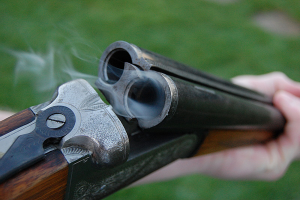 For millions of Americans, shooting firearms is a satisfying hobby and a great way to exercise our unique rights. And the cornerstone of this activity is safety. The vast majority of gun owners know just how dangerous firearms can be, which is why they are so cautious around their firearms. Gun culture is steeped in safety and conscientiousness, and for good reason.
For millions of Americans, shooting firearms is a satisfying hobby and a great way to exercise our unique rights. And the cornerstone of this activity is safety. The vast majority of gun owners know just how dangerous firearms can be, which is why they are so cautious around their firearms. Gun culture is steeped in safety and conscientiousness, and for good reason.
However, there’s one aspect of gun safety that is often overlooked. Most gun owners don’t concern themselves too much with the risks associated with lead exposure, and that’s not a euphemism for getting shot. It turns out that merely shooting a firearm can give you a tiny dose of lead. And when you shoot a lot, those doses add up.
In a standard bullet, a solid lead core wrapped in a copper jacket sits atop a stack of gunpowder and lead primer. When the gun fires, the primer ignites, the gunpowder lights, and some of the lead on the bullet boils. When the casing snaps out of the ejection port, lead particles trail behind it. As the bullet hurtles down the barrel of the gun, a shower of lead particles follows.
If a gun range isn’t ventilated well, lead dust collects on shooters’ clothing and hands and lingers in the air, where it can be inhaled. The more people shoot, the greater the risk of being exposed to dangerous amounts of lead. It becomes an occupational hazard for weapons instructors, police and defense personnel.
It can also put family members at risk. A 1-year-old boy in Connecticut was found to have high blood lead levels at a routine doctor’s visit. There were no lead paint or pipes in the child’s home. The exposure was traced to his father’s job as a maintenance worker at an indoor shooting range; the father cared for his son after work in lead-contaminated clothing, according to a 2015 report from the state public health department.
The people who are most vulnerable to lead exposure from firearms, are the gun range workers, especially if they work at indoor ranges with poor ventilation (which is more common than most people realize). Also at risk, are avid shooters, and people who work in professions that require them to frequently train with firearms, such as police officers and military personnel. However, some people think that the risk is overblown.
The issue of lead exposure and firearms is divisive, even the question of whether higher lead levels are unsafe. “Well, that’s their opinion,” says Larry Keane, the vice president and general counsel for the National Shooting Sports Foundation. “We believe there are efforts by others that want to diminish people’s participation in shooting sports or exercise their second amendment rights. They put out or advocate positions that are unsupported by the evidence.”
That’s an understandable sentiment. Gun owners are used to having their hobby demonized and undermined by politicians and activists. It wouldn’t be a surprise if someday, anti-gun politicians latch on to this issue, and use it to regulate shooting ranges out of existence, or scare would-be gun owners.
However, the truth is there is a problem with lead exposure at gun ranges. Its a fact gun ranges are rarely inspected by OSHA, according to a Seattle Times investigation. They also found that in many cases, range owners were negligent and had poorly ventilated facilities. Or they were unaware of the hazard, which is understandable. Even though every shooter knows that their bullets contain lead, this issue isn’t really on the radar of the shooting community.
It’s also true that generally speaking, shooting firearms can increase your lead exposure, regardless of whether or not you shoot at a poorly ventilated indoor range. A recent examination of 36 previous studies that looked at the lead levels of avid shooters, found that just about every shooter has blood lead levels that are higher than what is considered safe by the CDC. If you use a firearm on a regular basis, you probably have more lead in your body than the average person.
So is this something that gun owners really need to worry about? In short, yes. No amount of lead is safe for the human body. Even in small amounts, it’s still going to do damage to you, and you may not have symptoms of lead poisoning right away. And these symptoms aren’t exactly telling. They include things like irritability, high blood pressure, joint pain, and poor memory. If you started suffering from those conditions, would you immediately assume that it was from using firearms?
However, we shouldn’t let this danger stop us from enjoying firearms. There are things we can do to mitigate the risk of lead exposure. The researchers who studied lead exposure among shooters, recommended changing your clothes after visiting a shooting range, and not smoking or eating at the range. Wearing gloves while shooting would probably also be a good idea. And most importantly, use ammunition that contains lead free primers.
Gun owners are already well known for being obsessed with safety, and taking every necessary precaution when handling firearms. It only makes sense that we stop ignoring this issue, and start protecting ourselves and our families from lead.
